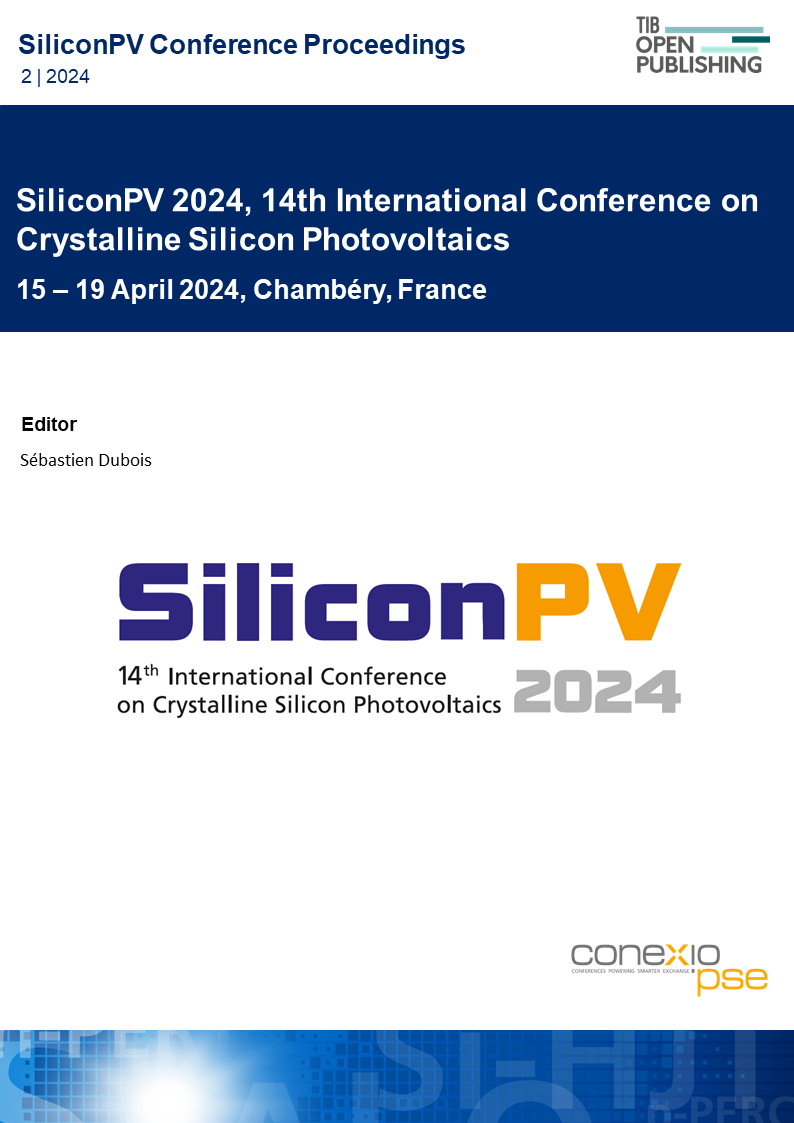Recovery of Silicon Kerf Through Oxidative Cleaning and Drying Process
DOI:
https://doi.org/10.52825/siliconpv.v2i.1301Keywords:
Kerf, Silicon, Recycling, Oxidative Process, Cleaning ProcessAbstract
High quantity of slurries, kerf, are generated during ingot wafering and represent up to 40% of the silicon in weight. The highly pure silicon contained in kerf is contaminated with organics, metal impurities, water and an oxide layer. The recovery of the silicon could be an efficient way to reduce costs in the production of solar panels through material and energy savings. At high temperatures, organic contamination causes the formation of silicon carbide species that are difficult to segregate during kerf remelting into a pure silicon ingot. Also, during the fusion of silicon, temperatures up to 1500°C are reached and the mixture of silicon and water forms oxides and gases that reduce production yields and affect melting conditions. For these reason, purification and drying steps are required to ensure proper silicon raw material for remelting into ingots. So far, approaches using strong acidic or organic solvent are used to reduce contamination by organic compounds. In this study, more environmentally friendly processes were applied on authentic kerf waste to purify and dry silicon, to make it suitable as raw material for silicon ingot preparation. The amount of water and organic compounds were monitored along the process steps. Using aqueous oxidative processes in combination with filtration, kerf was cleaned and a total carbon reduction of at least 30% was observed. The control of humidity enables the convenient conditioning of purified kerf and effective drying reduced the moisture content to less than 5% wt.
Downloads
References
[1] D.Ginley, M.A. Green, R. Collins, “Solar energy conversion towards 1 Terawatt” MRS Bull, 33 (4) 355-364 (2011) https://doi.org/10.1557/mrs2008.71
[2] B. Parida, S. Iniyan, R. Goic, “A review of solar photovoltaic technologies”, Renw. Sust. Energ., 15 (3) 1625-1636 (2011) https://doi.org/10.1016/j.rser.2010.11.032
[3] G. Mesaritis, E. Symeou, A. Delimitis, S. Oikonomidis, M. Jaegle, K. Tarantik, C. Ni-colaou, T. Kyratsi, “Recycling Si-kerf from photovoltaics : A very promising route to thermoe-lectrics”, J. Alloy Compd, 775, 1036-1043 (2019) https://doi.org/10.1016/j.rser.2010.11.032
[4] N. boutoutchent-Guerfi, N. Drouiche, S. Medjahed, M. Ould-Hamou, F. Sahraoui, “Disposal of metal fragments released during polycrystalline slicing by multi-wire saw”, J. Cryst. Growth, 447, 27-30 (2016) https://doi.org/10.1016/j.jcrysgro.2016.04.017
[5] H.S. Gopala Krisma Murthy, “Evolution and present status of silicon carbide slurry recovery in silicon wire sawing”, Resour. Conserv. Recy., 104, 194-205 (2015) https://doi.org/10.1016/j.resconrec.2015.08.009
[6] N.P. Wagner, A. Tron, J.R. Tolchard, G. Noia, M. Pawel Bellmann, “Silicon anodes for lithium-ion batteries produced from recovered kerf powders”, Journal of Power Sources, (414), 486-494, (2019) doi.org/10.1016/j.jpowsour.2019.01.035.
[7] X. Jin, Y. Zhuang, P. Xing, J. Kong, X. Zhou, [ceramics] X. Han,”Preparation of reac-tive sintering Si3N4-Si2N2O composites ceramics with diamond-wire saw powder waste as raw material”, Journal of Hazardous Materials, 400, 123145 (2020) doi.org/10.1016/j.jhazmat.2020.123145
[8] K.Tomono, S. Miyamoto, T. Ogawa, H. Furuya, Y. Okamura, M. Yoshimot, R.Komatsu and M. Nakayama, “Recycling of kerf loss silicon derived from diamond-wire saw cutting process by chemical approach”, Separation and Purification Technology 120, 304-309 (2013). doi.org/10.1016/j.seppur.2013.10.014
[9] Y. Zhang, W. Sheng, L. Huang, C. Zhang, X. Tang, X. Luo, “Recovery of silicon kerf waste from diamond wire sawing by two-step sintering and acid leaching method”, Journal of Cleaner Production (265) 121911 (2020), doi.org/10.1016/j.jclepro.2020.121911.
[10] L. Zhang, A. Ciftja, “Recycling of solar cell silicon scraps through filtration, Part I: Ex-perimental investigation, Solar Energy Materials and Solar Cells”, (92) 11, 1450-1461 (2008) doi.org/10.1016/j.solmat.2008.06.006.
[11] S.A. Sergiienko, B.V. Pogorelov, V.B. Daniliuk, “Silicon and silicon carbide powders recycling technology from wire-saw cutting waste in slicing process of silicon ingots”, Separa-tion and Purification Technology, (133), 16-21 (2014) doi.org/10.1016/j.seppur.2014.06.036.
[12] L. Huang, A. Danaei, M. Fang, S. Thomas, X. Luo, M. Barati , “A metallurgical route to upgrade silicon kerf derived from diamond-wire slicing Process “, (18) 32619-8 (2019) doi.org/10.1016/j.vacuum.2019.02.019
[13] G. Chen, Y. Li, L. Huang, J. Peng, L. Tang, X.Luo, “Recycling silicon kerf waste: Use cryolite to digest the surface oxide layer and intensify the removal of impurity boron”, Journal of Hazardous Materials, (423) 126979, (2022), doi.org/10.1016/j.jhazmat.2021.126979
[14] L. Pietrelli, S. Ferro, A. P. Reverberi and M. Vocciante, "Removal of polyethylene gly-cols from wastewater: A comparison of different approaches", Chemosphere (273), 129725 (2021). doi.org/10.1016/j.chemosphere.2021.129725
Published
How to Cite
Conference Proceedings Volume
Section
License
Copyright (c) 2024 Marion Chevallier, Jean-Baptiste Antoine, Francis Marchitto, Yoann Doré, Yun Luo, Yohan Parsa

This work is licensed under a Creative Commons Attribution 4.0 International License.
Accepted 2024-09-10
Published 2025-02-03
Funding data
-
Horizon 2020 Framework Programme
Grant numbers 958365
